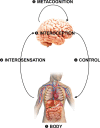Pathophysiological and cognitive mechanisms of fatigue in multiple sclerosis
- PMID: 30683707
- PMCID: PMC6581095
- DOI: 10.1136/jnnp-2018-320050
Pathophysiological and cognitive mechanisms of fatigue in multiple sclerosis
Abstract
Fatigue is one of the most common symptoms in multiple sclerosis (MS), with a major impact on patients' quality of life. Currently, treatment proceeds by trial and error with limited success, probably due to the presence of multiple different underlying mechanisms. Recent neuroscientific advances offer the potential to develop tools for differentiating these mechanisms in individual patients and ultimately provide a principled basis for treatment selection. However, development of these tools for differential diagnosis will require guidance by pathophysiological and cognitive theories that propose mechanisms which can be assessed in individual patients. This article provides an overview of contemporary pathophysiological theories of fatigue in MS and discusses how the mechanisms they propose may become measurable with emerging technologies and thus lay a foundation for future personalised treatments.
Keywords: dopamine; dyshomeostasis; inflammation; interoception; lesion; metacognition; network.
© Author(s) (or their employer(s)) 2019. Re-use permitted under CC BY-NC. No commercial re-use. See rights and permissions. Published by BMJ.
Conflict of interest statement
Competing interests: None declared.
Figures



References
Publication types
MeSH terms
LinkOut - more resources
Full Text Sources
Other Literature Sources
Medical
